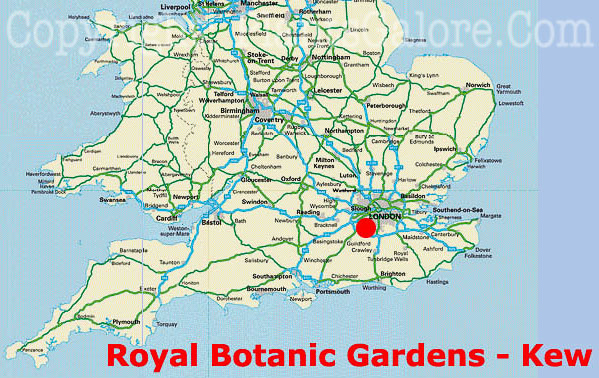The
Royal Botanic Gardens at Kew, is situated on the banks of the
River Thames between Richmond and Kew in south-west London.
The Gardens comprise comprise 132 hectares, most of which is
intensely managed, and includes a very extensive arboretum,
water features, herbaceous bedding, some of the world's
largest and most famous botanical glasshouses, and many
historic buildings.
The Gardens are "royal" because
for many years before Kew became a national botanical
institute kings and other members of the royal family either
lived on or owned the land and buildings at the present site.
The plural form, "gardens", is correctly used because two
separate parts of the royalty owned adjacent plots of land -
the Richmond Estate and the Kew Estate - which were combined
into a single area around 200 years ago.
|
|

|
|
|
In
the 1720s George II and Queen Caroline lived at Ormonde Lodge
on the Richmond estate next to the river. In the early 1730s
their son Frederick, Prince of Wales, leased the neighboring
Kew estate, which extended from Kew Green to the present
southern boundary of the Gardens near the
Pagoda. Prince Frederick died in 1751, and in 1759
Augusta, his widow, founded a botanic garden of about 3.5
hectares (9 acres) on the land south of the Orangery, with
advice from her head gardener, William
Aiton, and her botanical adviser,
Lord Bute.
The architect
Sir
William Chambers designed a number of buildings for the
garden and surrounding grounds: those still standing include
the Orangery, Pagoda and
Ruined Arch.
|
|
|
George
III, son of Frederick and Augusta, inherited the Richmond
Estate in 1760 when his grandfather died. In 1766
Lancelot
"Capability" Brown began to redesign the Richmond Gardens
for the King and Queen Charlotte, notably using the device
known as a ha-ha to mark boundary lines without marring the
view. George III took over the Kew Estate in 1772, when his
mother died.
Sir
Joseph Banks became unofficial director and the subsequent
fame of the botanic gardens is largely due to him. Under his
direction collectors went all over the world in search of
plants of economic, scientific or horticultural interest.
|
|
|
With
the deaths of both George III and Sir Joseph Banks in 1820,
the botanic gardens fell into decline and in 1840, they were
handed over to the State. Soon after, the Royal family donated
additional areas of surrounding land - thereby extending the
size of the Gardens to 81 hectares. The following year,
Sir
William Hooker was appointed as the first official
director. He established the Museums and Department of
Economic Botany in 1847 and the
Herbarium and Library in 1852. The
Palm
House was finished in 1848 and in 1860 construction began
on the
Temperate House, both designed by
Decimus
Burton.
Sir William's son and
successor,
Sir
Joseph Hooker, oversaw the founding of the
Jodrell Laboratory in 1876. In 1882, the
Marianne North Gallery was donated to the Gardens and in
1897
Queen Charlotte's Cottage and its grounds were given by
Queen Victoria, to commemorate her Diamond Jubilee.
|
|
|
In
1904,
Cambridge Cottage and its garden, now the home of the Kew
Gardens Gallery, were presented by Edward VII on the death of
the last Duke of Cambridge, and the Gardens reached their
present size of 120 hectares (about 300 acres).
Among the buildings constructed
during the latter half of the last century are the
Evolution House (opened in 1952),
Princess of Wales Conservatory (opened in 1987),
Sir
Joseph Banks Building (opened in 1990), and the Victoria
Gate Visitor Centre (opened in 1992).
|
Famous plants people associated with the Royal Botanic
Gardens at Kew include:
Sir
Joseph Banks,
Sir
Joseph Hooker,
Allan Cunningham,
Augustine Henry,
Sir William Jackson Hooker,
Francis Masson,
William Andrews Nesfield,
|
|

|
|
|
Royal Botanic Gardens
at Kew
Richmond
Surrey TW9 3AB
|
 |
 |
|
|

|

I've been to Kew three times over the
years. I suspect that it was even more magnificent before "The
Great Storm" in 1987 that blew over many ancient trees. Now, my
favorite areas are the rock garden and the conservatory.
Things are pretty well labeled and there is a lot to see but
this garden is not as spectacular as say,
Wisley or
Sissinghurst. At least that is my humble opinion
(IMHO for you techies.)
Some of the plants named in honor of Kew
include Buddleja colvilei ‘Kewensis’, Caryopteris
x clandonensis ‘Kew Blue’, Cytisus x
kewensis, Euonymus fortunei ‘Kewensis’, Iris
chrysographes ‘Kew Blak’, Lavatera x clementii
‘Kew Rose’, Skimmia x confuse ‘Kew Green’ and
Sorbus x kewensis.
|
|
 |
|
|
|
|



